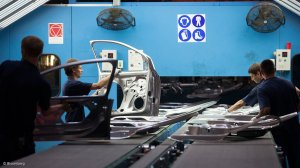The latest studies, released in May, in a continuing series of research studies indicate that steel autobody structures can be as lightweight as the current aluminium bodies and meet all safety crash-test performance standards.
The studies – 3B Forming and Crash Optimisation, Future- SteelVehicle (FSV) Final Gauge Optimisation and FSV Near-Term Front Longitudinal Rail Shape – were commissioned by automotive group of the World Steel Association WorldAutoSteel, and engineering consultant Engineering Technology Asso-ciates conducted the actual engineering studies.
This series of studies indicates that car manufacturers can form and fabricate sophisticated steel designs, thereby accelerating the implementation of the technology in production vehicles.
In addition to a weight reduc- tion of 35% in its initial FSV design in 2011, the most recent studies indicate a further boost in mass savings to 39%. The opti- mised FSV body would weigh 176.8 kg, putting steel on a par with current aluminium production designs.
An industry database of current production vehicles, known as A2mac1, shows the lightweight, advanced high-strength steel (AHSS) body structures, designed to carry heavier electrified powertrains, are in line with the lightest internal-combustion-engine aluminium vehicles and other concepts featuring multimaterial solutions.
The updated study results also show that, by incorporating FSV technology, car manufacturers can avoid pursuing costlier alter- natives involving the use of competing materials and multimaterial designs to achieve their goals.
“Our latest lightweighting projects show the continuing potential of steel and demonstrate how carmakers can take advantage of steel’s design flexibility and use advanced high-strength steels to meet the difficult challenges of improving fuel economy and reducing greenhouse-gas emissions,” says WorldAutoSteel director Cees Ten Broek.
The intensive use of AHSS, as the FSV has demonstrated, also contributes to lower total greenhouse-gas emissions over the entire vehicle life cycle, com- pared with more expensive and energy-intensive low-density materials.
This advantage in lower total life cycle emissions increasingly aligns steel use with regulations that comprehend all sources of emissions and not only those from the vehicle-use phase.
The FSV programme developed optimised AHSS body structures for four proposed vehicles from 2015 to 2020 – battery electric and plug-in hybrid electric vehicles (PHEVs) for the A and B class, as well as PHEV and fuel cell C- and D-class vehicles.
Through FSV’s development, focused on electrified powertrains, the design and material advancements are equally applicable to any type of automobile. The FSV programme employs advanced steels and steel technologies and consequently adds to the tool sets of automotive engineers worldwide. It also uses more than 20 new AHSS grades, representing materials expected to be commercially available in the 2015 to 2020 technology horizon.
The FSV material portfolio includes dual-phase transformation-induced plasticity and twinning-induced plasticity, as well as complex-phase and hot-formed steels, which reach into gigapascal strength levels and are the newest in steel technology offered to the industry.
“Steel is the most environmentally sound material used in automotive manufacturing. “It achieves not only the light weight that manufacturers require but it is also superior to any other material in terms of manufacturing and recycling emissions. “Therefore, on a life-cycle basis, it is better for the environment,” says Ten Broek.
Edited by: Martin Zhuwakinyu
Creamer Media Senior Deputy Editor
EMAIL THIS ARTICLE SAVE THIS ARTICLE
To subscribe email subscriptions@creamermedia.co.za or click here
To advertise email advertising@creamermedia.co.za or click here













